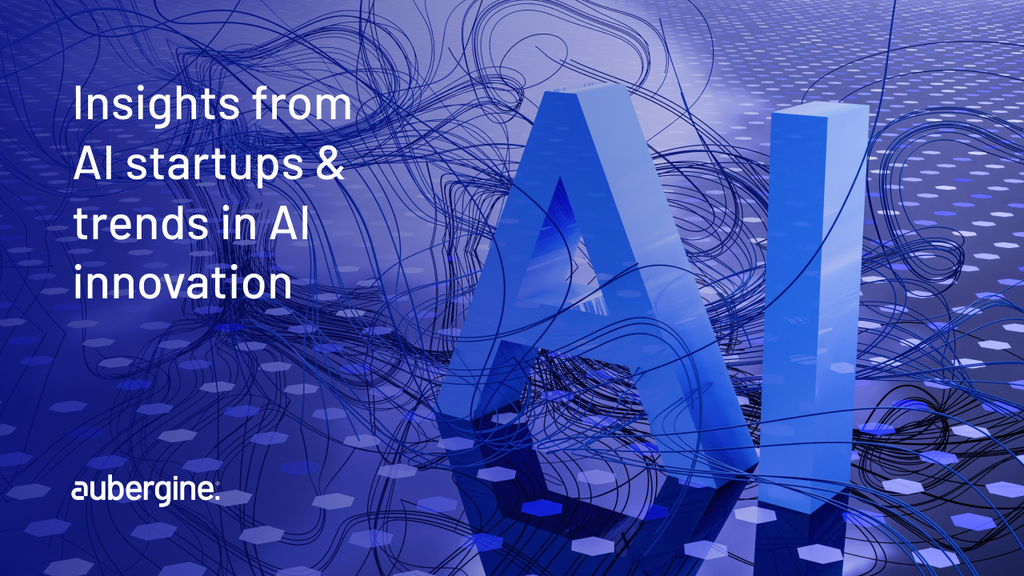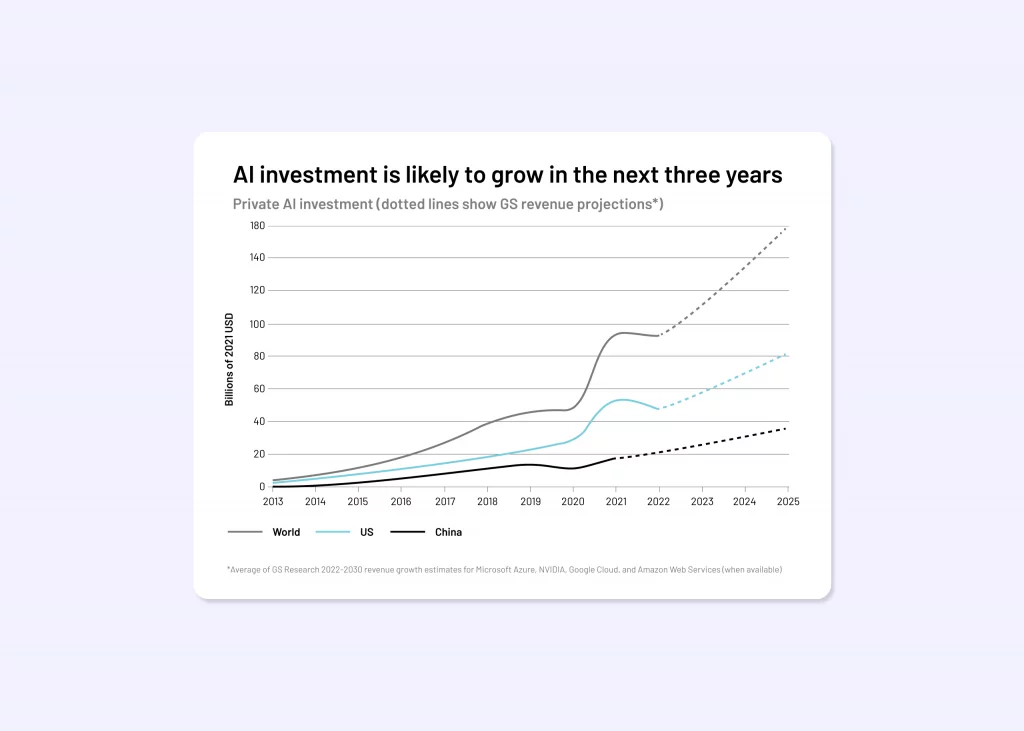
The current AI ecosystem is extremely volatile and brimming with new businesses that are trying to find success with the recent exponential growth in AI technologies. While some businesses have invested millions of dollars in building and training their own AI models, most companies have preferred the simplified approach of building wrapper apps around existing AI functionalities.
This highlights an important trend in the tech industry, where the accessibility of AI technologies is significantly enhanced by tools that simplify interaction with complex AI models.
Investment in AI startups is at an all-time high, with venture capital flowing freely into AI ventures.

Moreover, the average deal size for AI startups grew by 48% year-to-date in 2023, fueled by mega-rounds exceeding $100 million. This trend indicates a preference for larger investments in promising AI ventures, particularly those exploring cutting-edge technologies like generative AI.
There’s also a growing interest in startups developing AI solutions tailored to specific industries, like healthcare, finance, agriculture, and manufacturing. This trend reflects a shift from general AI technologies to more specialized applications that solve industry-specific problems, offering clear ROI to potential clients and attracting targeted investments.
Inside this seemingly endless sea of innovation and noise, there are pioneers and legacy innovators who are not just participating in the AI revolution but are also defining it. These are the entities that, despite the crowded marketplace, find ways to break new ground and shape the direction of AI.
It’s 2018, and the Hugging Face team in New York City is about to have a big moment.
Their screens glowing with the latest results from their Transformer models – they realise this isn’t just another day at the office; they’re about to release a model that will redefine NLP (natural language processing) in months to come.
Soon, they created & shared an open-source library called Transformers, making cutting-edge NLP technologies accessible to developers worldwide.
Today, in just 5 years – the company is valued at $4.5B, with $200M+ raised in funding.
Success stories of AI startups like these are everywhere. But there’s a bigger question for digital product stakeholders to consider. AI is knocking on the doors of software development and design for digital products across industries and job functions.
In this paradoxical environment, where saturation and opportunity coexist, the challenge for AI innovators isn’t just navigating the crowds. It’s about being on your toes like a true navigator.
So what can these stories of AI applications across different industries teach us?
The story of IBM Watson & Freenome
While legacy and experience are invaluable assets, the ability to quickly adapt, zero in on a niche, and execute with precision can often lead to breakthroughs in uncharted territories.
IBM Watson aimed to transform cancer treatment by leveraging AI to recommend the best suited cancer treatment to doctors globally. The integration of Watson’s AI technology into existing healthcare workflows proved more difficult than anticipated, and IBM’s high-profile partnership with MD Anderson Cancer Center in Texas fell apart due to insufficient data, complexity of patient files, and lack of relevant recommendations.
Then there is Freenome. A relatively new company founded in 2014, the startup has garnered significant attention and funding for its innovative approach to cancer detection.
Freenome’s approach is different from IBM Watson’s, as it aims to analyze biomedical data to detect cancer in its earliest, more treatable stages, rather than trying to revolutionize cancer treatment through AI.
Freenome has raised a total of $1.4 billion over 9 rounds from 65 investors, including Roche, T. Rowe Price, BrightEdge Fund and others.
The Story of Tomorrow.io
Founded in 2015, Tomorrow.io set out to optimise weather forecasting using AI and big data analytics. Their technology leverages many data sources, including satellite images, weather stations, airplanes, and drones, to provide hyper-accurate weather predictions.
By applying machine learning algorithms to this data, Tomorrow.io can offer precise weather forecasts at a granular level, which is crucial for the agriculture, aviation, and logistics industries.
One of the most significant sustainability impacts of Tomorrow.io’s technology is in agriculture, empowering 700+ farmers to monitor crop health. Their accurate weather forecasting can lead to more efficient water use, better crop planning, and ultimately, reduced environmental impact.
Additionally, Tomorrow.io’s platform assists cities and governments in climate adaptation strategies. By providing detailed forecasts and climate simulations, these entities can prepare for extreme weather events, reduce the risk of disaster, and help protect communities and infrastructure. This capability is increasingly critical as climate change leads to more frequent and severe weather events globally.
By making weather data more accessible and actionable, Tomorrow.io is addressing multiple sectors like agriculture, aviation, and logistics industries making their solution economically viable via widespread adoption.
The company is also committed to offsetting its environmental impact from AI through focused and well-planned ESG efforts. Tomorrow.io has planted 5,000+ trees as part of its carbon-offsetting programs. Their future goals include mitigating Scope 1 and Scope 2 emissions to net-zero.
The story of TypingMind
TypingMind began with a simple yet ambitious goal: to enhance the experience of interacting with generative AI models like ChatGPT.
The founders, coming from diverse backgrounds in software engineering and digital marketing, noticed a gap between the powerful technology of AI models and the ease of access for the average user. Their frustration was driven by clunky interfaces and limited user engagement options with existing AI tools.
The turning point for TypingMind came through a combination of user feedback and deep market analysis. Users expressed frustration over TypingMind’s steep learning curve and impersonal interactions. So TypingMind decided to pivot.
TypingMind’s pivot was grounded in user-centric design principles. They introduced customizable features allowing users to tailor their AI interactions. The impact of TypingMind’s pivot was profound. User engagement metrics soared, with significant increases in daily active users and session times.
The platform’s user base expanded beyond tech enthusiasts to educators, creatives, and professionals seeking to leverage AI for various needs, marking TypingMind as a versatile tool.
Lesson? The path to AI-driven success lies not just in technological advancement but in its application with intent and understanding of users. The magic happens at the intersection of user-centric design, market feedback, insight on market gaps, and strategic agility.
MoE divides complex problems into smaller, more manageable segments, allowing individual “expert” models to tackle specific aspects based on their specialized capabilities.
Implementing MoE in digital product development offers significant benefits by enhancing personalization, optimizing user interfaces, automating operations, and refining content delivery.
Here’s how digital product owners can leverage MoE technology efficiently:
Personalization: Use MoE to fine-tune product recommendations and services, creating a highly personalized user experience by understanding diverse user behaviors and preferences.
Operational efficiency: Automate complex decision-making in backend operations such as pricing, inventory management, and customer support, leading to smarter automation, cost savings, and improved service quality.
Data-driven product improvements: Utilize MoE for in-depth analysis of product usage and performance, guiding data-informed enhancements and optimizations.
Vector Memory stands out for its ability to quickly access and use historical information from a vector-based storage system. Essential for neural networks and transformers, it supports fast learning and adaptation by leveraging past data.
A robust vector database offers essential features like data management, fault tolerance, security measures, and a query engine. These functionalities enable efficient operation of workloads, easy scaling, maintaining scalability, and fulfilling security needs.
Here’s how digital product owners can leverage vector memory technology efficiently:
Enhanced search capabilities: Integrate vector memory into your product to significantly improve search functionalities. It enables nuanced search experiences by understanding and retrieving information based on similarity, beyond keyword matching.
Scalable data analysis: Leverage vector memory’s efficient data retrieval for scalable, real-time data analysis. This allows for processing large volumes of data quickly, aiding in decision-making and product optimization.
Security and reliability: Ensure your product leverages vector databases that prioritize fault tolerance and security features. This maintains high availability and protects user data, boosting trust in your product.
Federated Learning is a decentralized approach to machine learning where the model is trained across multiple devices or servers, holding local data samples without exchanging them. This method enhances privacy and reduces the need for data centralization, making it particularly useful for sensitive or proprietary data.
Federated learning enables the creation of personalized models for word prediction, face recognition for secure login, and voice recognition in virtual assistants like Siri or Google Assistant, directly from data on users’ smartphones. This approach enhances user experience personalization without compromising privacy.
How digital product stakeholders can leverage this technology:
Efficient use of bandwidth: Use federated learning for products operating in environments with limited bandwidth. By training models locally and only exchanging model updates, you can minimize bandwidth usage.
Real-time learning: Implement federated learning for products requiring real-time updates and learning from user interactions. This approach allows for continuous improvement of the AI model based on the latest user data.
Cross-device compatibility: Utilize federated learning in products that span multiple devices, enabling seamless model updates and learning across different platforms without sharing raw data.
QML merges quantum computing principles with machine learning algorithms to process information in fundamentally new ways. By exploiting quantum mechanics’ peculiarities, QML promises to dramatically enhance computational speed and capacity, particularly for specific tasks like optimization, pattern recognition, and complex simulations.
How digital product stakeholders can leverage this technology-
Speeding up simulations: QML’s capability to quickly perform complex simulations can be particularly beneficial for products in finance, pharmaceuticals, and environmental science, where simulating molecules, markets, or climate patterns is essential.
Optimization problems: Quantum computing excels at solving optimization problems more efficiently than classical computers. Digital product owners can use QML for optimizing logistics, supply chain management, or even for enhancing computational aspects of AI-driven features within their products.
Innovative product features: QML opens up possibilities for new product features that were previously computationally infeasible, such as highly sophisticated AI models for personalized user experiences, real-time language translation, or complex decision-making tools.
And so the buzz about AI and automation shows us something important: the future calls for those who are ready to innovate while being mindful of the broader implications. The AI sector is a fertile ground for innovation, demanding clarity and purpose from those who venture in to reap the benefits.
At Aubergine Solutions, we’re not just building AI solutions; we’re crafting the future of technology. Deeply embedded in user-centric product development, we empower digital product stakeholders to transcend traditional boundaries and foster groundbreaking innovation using AI.

